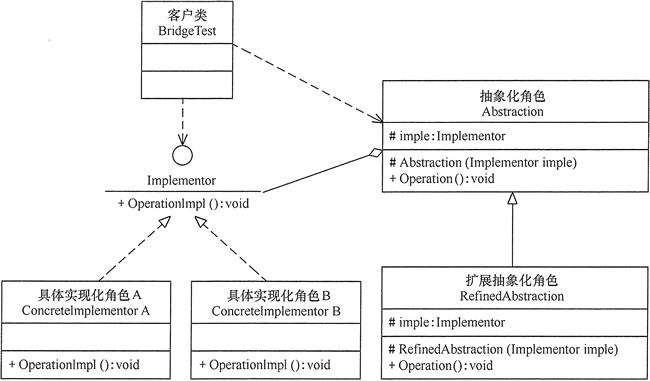桥接模式
点击打开在线编译器,边学边练
桥接模式是一种结构型设计模式,它的主要目的是将抽象和实现分离,使它们可以独立地变化。桥接模式通过使用组合关系来连接抽象和实现,而不是继承。
在实际应用中,桥接模式非常适用于多维度变化的场景。它可以解耦抽象和实现,使它们可以独立地扩展和演化。同时,桥接模式还可以简化类的继承关系,减少子类的数量。
在桥接模式中,有两个关键角色:
1. Abstraction(抽象类):它定义了对客户端的抽象接口,并包含一个对实现类的引用。它通常提供一些高级操作,而这些操作由实现类来实现。
2. Implementor(实现类接口):它定义了对实现的抽象接口。实现类接口通常提供一些基本操作的接口,而这些接口由具体的实现类来具体实现。

下面是一个简单的Java示例,展示了如何使用桥接模式:
// Implementor interface
public interface DrawingAPI {
void drawCircle(int x, int y, int radius);
}
// Concrete Implementor 1
public class DrawingAPI1 implements DrawingAPI {
@Override
public void drawCircle(int x, int y, int radius) {
System.out.println("API1.circle at " + x + ":" + y + " radius " + radius);
}
}
// Concrete Implementor 2
public class DrawingAPI2 implements DrawingAPI {
@Override
public void drawCircle(int x, int y, int radius) {
System.out.println("API2.circle at " + x + ":" + y + " radius " + radius);
}
}
// Abstraction
public abstract class Shape {
protected DrawingAPI drawingAPI;
protected Shape(DrawingAPI drawingAPI) {
this.drawingAPI = drawingAPI;
}
public abstract void draw();
}
// Refined Abstraction
public class CircleShape extends Shape {
private int x, y, radius;
public CircleShape(int x, int y, int radius, DrawingAPI drawingAPI) {
super(drawingAPI);
this.x = x;
this.y = y;
this.radius = radius;
}
@Override
public void draw() {
drawingAPI.drawCircle(x, y, radius);
}
}
public class BridgePatternDemo {
public static void main(String[] args) {
Shape circle1 = new CircleShape(1, 2, 3, new DrawingAPI1());
Shape circle2 = new CircleShape(4, 5, 6, new DrawingAPI2());
circle1.draw();
circle2.draw();
}
}在这个示例中,DrawingAPI接口定义了一个绘制圆的方法。DrawingAPI1和DrawingAPI2是具体的实现类,它们实现了绘制圆的具体逻辑。
Shape类是抽象类,它包含一个对DrawingAPI的引用,并提供了一个抽象的draw()方法。CircleShape是Shape的具体子类,它实现了draw()方法,并调用了DrawingAPI来绘制具体的图形。
通过使用桥接模式,我们可以将抽象和实现分离,可以灵活地扩展和演化。这使得我们可以根据不同的需求来定制具体的实现,而不必修改大量的代码。
本文固定URL:https://www.dotcpp.com/course/1365